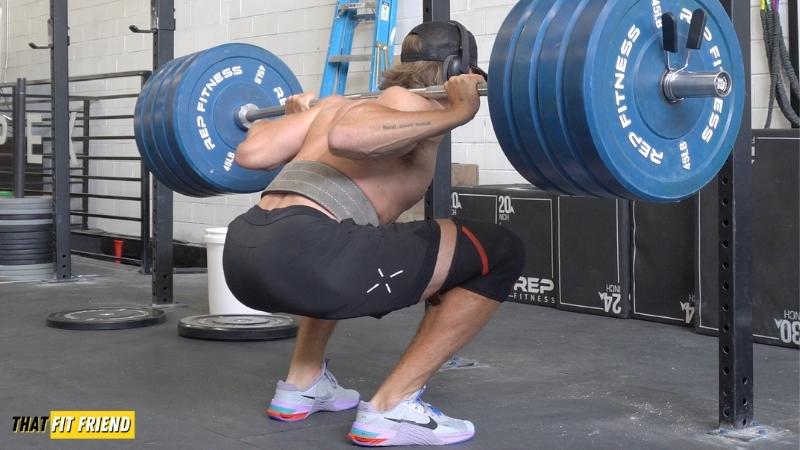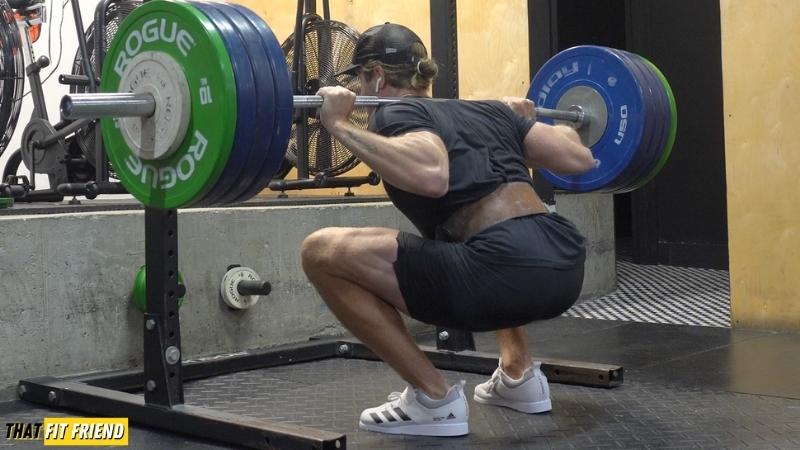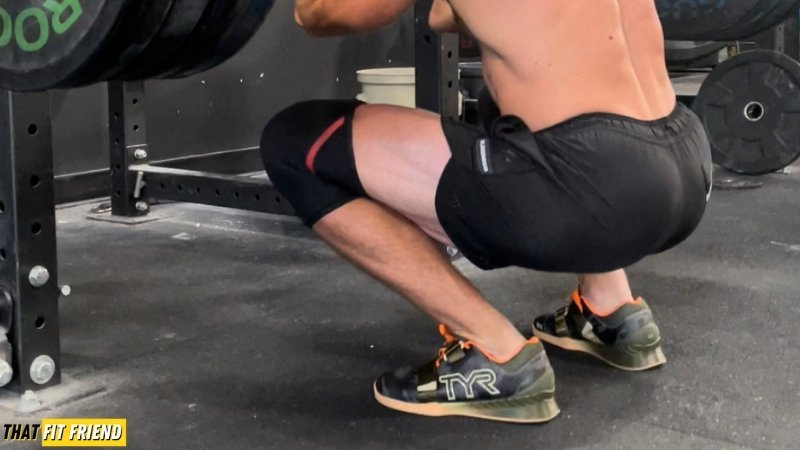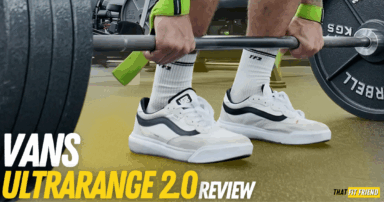Knee sleeves can be fantastic tools in the gym for supporting performance when squatting, tackling tough leg days, and prepping for strength sports. If you’re new to knee sleeves, then you may have wondered if they’re right for you.
For example, you may have asked questions like, “What do knee sleeves actually do?”, “Are knee sleeves worth it for me?”, “Will knee sleeves boost my cross-training and squat performance?”
These are all fantastic questions and if you’re getting more serious with your training, then it’s a good idea to explore the idea of investing in knee sleeves. Much like your gym shoes, knee sleeves can serve as tools for accomplishing various training tasks.
In this knee sleeves guide, I’ll cover multiple topics like how tight your knee sleeves should be, how to clean them, what they do, and much more.
Table of Contents+
What Are Knee Sleeves For?
Knee sleeves are pieces of supportive strength gear that are worn for working out and lifting for a variety of reasons. The most common reason lifters will wear knee sleeves is to provide their knee joints with additional support when working out.
The light to moderate layer of support and compression that knee sleeves provide can promote stronger lifter mechanics in certain training contexts.
For knee sleeve newbies, I like to describe knee sleeves as being similar to pieces of equipment like lifting belts, lifting straps, and weightlifting shoes. Are knee sleeves absolutely needed to have strong and successful training sessions? Not necessarily.
However, they have their time and place during workouts, and can certainly be useful as you’re getting more serious with your strength training or if just enjoy having additional support around your knees.
Knee sleeves can be useful to wear for squats, Olympic lifts, CrossFit workouts, and when doing accessory exercises like leg presses, hack squats, and walking lunges.
What Do Knee Sleeves Do and What Are Their Benefits?
Knee sleeves provide the knees with a light to moderate level of compression when working out. The compression that knee sleeves provide can do multiple things to support your training.
1. Knee Sleeves Can Make Us Feel More Stable
For starters, the compression that knee sleeves provide around the knees can provide the body with a proprioceptive cue that the joint is more stable. Essentially, the compression we “feel” can translate to the body perceiving the joint as being more stable.
Proprioception entails awareness or perception of movements of the body and where and how we’re moving through space and time. In the case of knee sleeves, this is the “feeling” that your nervous experiences then acts on with the additional compression.
If the body feels as though the joint is more stable, then you may experience increased confidence when lifting and you may notice that your mechanics “magically” seem to get more dialed in.
The proprioceptive effect of knee sleeves is really interesting and it’s something that is highly individual, so it’s worth noting that how you experience and interpret the feeling of knee sleeves may be different than mine and your peers.
2. Knee Sleeves Can Improve Confidence When Training
On top of their proprioceptive effect, knee sleeves can also support lifting performance by increasing our confidence when training. The layer of compression that they provide can improve our mindset when moving heavy weight, which can then translate to stronger performance.
For a practical example, if you’ve ever had to tape a joint while playing a sport, do you remember how you felt when playing with the tape on? More than likely you “naturally” had a little more confidence due to the increased level of support you felt.
Outside of subtly cueing confidence through an increased feeling of stability, knee sleeves can also help play a role in a strength athlete’s or lifter’s pre-lift regimen.
For example, let’s say you’re doing heavy squat singles and you have a string of cues and things you do to mentally and physically prep for the execution of those squats. Using or wearing knee sleeves can play a role in this, AKA when the knee sleeves come on “it’s time to go”.
3. Knee Sleeves Can Promote Joint Warmth
Joint warmth is another interesting topic because it can highly individual and how we interpret warmth can be different from one another. For example, I respond better to warmer climates, so I’ll typically wear sweats for my warm-ups in cooler months, then switch to knee sleeves.
Like sweats, knee sleeves can promote joint warmth around the knees which can translate to increased performance for some athletes and lifters. If you like feeling warmer when training, then you’ll likely resonate with leaving your knee sleeves on between sets.
On top of promoting joint warmth, knee sleeves can also play a role in speeding up warm-up times. In the winter, if I’m feeling colder than normal, I might ditch my sweats right away and opt for knee sleeves instead because they can provide more local warmth to the knees.
Are Knee Sleeves Worth It?
Knee sleeves can absolutely be worth investing in for most lifters and athletes. There’s no right time or “strength level” to start using knee sleeves, and instead, I’d suggest shifting your mindset to thinking about them as tools.
Like lifting belts and lifting straps, knee sleeves have a time and place in the gym. For example, if you feel more confident when wearing knee sleeves or like how they promote joint warmth when training and squatting, then they’re a great tool to utilize.
On top of this, if you plan to compete in strength sports like powerlifting, CrossFit, or weightlifting, then acclimating to knee sleeves and getting used to what you’ll be wearing in competition can be really important.

Whether you’re a beginner or an experienced lifter, knee sleeves can be a great investment, especially if they help promote stronger performance under the bar and improve your confidence when training.
What If I Get Too Used to Knee Sleeves?
If you are nervous about getting “too used” to knee sleeves which is a concern I hear from some lifters, you can always plan training days where you go naked knee or go no knee sleeves for warm-up sets, then switch to sleeves at certain thresholds.
For certain cross-training and lifting days, I find this to be a useful strategy because it provides me with two different feelings when training and it allows me to “flip the switch” when the knee sleeves come on for heavier strength days.
In my coaching opinion, I would try to not think about knee sleeves in this context, but instead, simply look at them as tools and program sessions accordingly. If you’re really worried about this aspect, simply program for naked knee training days.
How Tight Should Knee Sleeves Be?
Knee sleeve tightness, and how tight knee sleeves should be, is highly individual and there really isn’t a one-size-fits-all tightness. Knee sleeve tightness can vary based on your personal preferences, what you plan to use the knee sleeves for, and how the knee sleeves are built.
Generally speaking, if you’re at a complete loss on how tight your knee sleeves should be, you’ll want to be able to put them on with relative ease and have them stay on and secure while you train.
If you can’t get the knee sleeves on at all or it’s a serious battle, then they’re likely too tight, and if they’re sliding down while training, then they’re likely a little too big.
For an at-home test, put your knee sleeves on and do 10 air squats, then move into 10 bodyweight lunges (5 on each side). If your knee sleeves move at all or come down during those 20 reps, then they may be a little too loose.
On that note, if you ever find yourself in-between sizes for knee sleeves, I often suggest sizing down as most knee sleeves will stretch out over time and if they run too big, to begin with, the chance of them getting snugger is slim to none.
When it comes to materials, typically, thicker knee sleeves will run a little more tight and rigid. For example, my 7mm neoprene Medium SBD Knee Sleeves run snugger and tighter than my 7mm medium Gym Reapers Knee Sleeves.
This discrepancy in tightness despite being the same size has to do with the construction and type of materials each knee sleeve uses, which I mentioned above. Neither is necessarily better or worse than the other, as tightness preference is once again individual.
If you’re wanting a pair of knee sleeves for powerlifting, you’ll likely want to air on the side of getting tighter knee sleeves, and if you’re wanting a pair for weightlifting and CrossFit, you’ll want a moderate level of tightness.
For general lifting, the world is your oyster and I’d suggest experimenting with different knee sleeve tightnesses to see what you like best for training and different types of workouts. To share context, I like SBD Knee Sleeves for squatting and Rehband or Gym Reapers for cross-training days.
When to Use Knee Sleeves
Knee sleeves and when to use them will depend on your training and preferences. There is no set rulebook for when to wear knee sleeves and I’d highly suggest experimenting with and without knee sleeves on different training days.
Typically, lifters and athletes will reach for knee sleeves for demanding squat workouts, lower body training days, and for their strength sport. Lifters and athletes may also wear knee sleeves for WODs and cross-training sessions depending on the exercises.
In reality, if you’re completely uncertain when to wear your knee sleeves, I’d suggest starting with your squat days and most demanding leg days and experimenting with if you like or dislike them for that context.
From there, you can then build out the “when” you prefer to wear knee sleeves and as you plug and play more, you’ll likely start to gravitate towards their use for certain training days and/or training intensities.
How to Clean Knee Sleeves
To clean your knee sleeves, I’d highly suggest handwashing them and spot-cleaning them. If you put your knee sleeves in the washer and dryer, then you may experience a faster level of breakdown with them.
Instead, do the following three steps. Do note, these steps will work for MOST knee sleeves, however, it’s always a good idea to check if your particular knee sleeves have care instructions for them as materials can vary.
Step 1: Grab a Mild Soap, Cold/Lukewarm Water, and Washcloth
You’ll want to use a mild soap that is void of harsh dyes and fragrances to avoid staining the materials or your knee sleeves. Plus, harsher soaps can result in breakdown issues at times.
I’d suggest also grabbing a clean washcloth to use for areas that need a little extra attention that your hand just isn’t doing the trick for. You’ll want to use cool or lukewarm water as well.
Step 2: Turn the Knee Sleeves Inside Out and Start Scrubbing
Apply a little soap to your knee sleeves and put some water on them, then start rubbing the soap in with your hands. You can also use the washcloth if you’d like, but I always suggest starting with your hand, then using the washcloth for trouble areas.
After you’ve scrubbed the knee sleeves, run the knee sleeves underwater for a brief moment to clear the soap from them. I would suggest running them underwater versus soaking them.
Step 3: Let Them Air Dry
After you’re happy with your knee sleeves’ cleanliness, keep them turned inside out, lightly squeeze and wring them out, and place them in a dry area. I’d suggest putting them near an air vent indoors so they can get a nice breeze on them.
If you want them to tighten up a little bit, you could try placing them in sunnier areas and this may cause them to get tighter and a little more rigid which could be a positive if you like tighter knee sleeves.
When to Replace Knee Sleeves
It’s usually pretty easy to tell when it’s time to replace your knee sleeve sleeves. For example, if you’re wondering if you should and notice that something is off your knee sleeves, then I would start the replacement process.
On top of this and if you’re still uncertain, you could look for key factors that would suggest it’s time to replace your knee sleeves. First, check out the materials and the build of your knee sleeves.
Are the materials still intact or are there areas where the stitching is coming undone and loose? Are the top and bottom of the knee sleeves still sewn together or are they starting to lose their shape and form?
Second, are the knee sleeves actually doing their job or are they becoming more of a burden to train with? For example, do you find yourself having to adjust your sleeves after every other set? If so, it may be time to replace them as they’ve stretched a little too much.
Again, there are multiple ways to tell when knee sleeves need to be replaced, but more often than not, you’ll have an internal inkling when it’s time. If you’re thinking about it, it likely needs to happen.
Frequently Asked Questions (FAQ)
Q:Will knee sleeves help my squat?
Q:What are the benefits of knee sleeves?
Q:Can beginners wear knee sleeves?
Takeaway Thoughts
Knee sleeves can be an incredibly useful piece of supportive strength gear. Like lifting straps, a good pair of knee sleeves and their utility will ebb and flow based on the context of one’s workout and preferences.
If you’re brand new to knee sleeves, I’d suggest starting to use them sparingly and slowly as this can help you acclimate to their difference in feeling when training and lifting.
If you have additional questions on knee sleeves and when to use them, drop a comment below or reach out to me personally via Instagram (@jake_boly or @that_fit_friend).




























Add a Comment